
Cardiff Bay is an area and freshwater lake in Cardiff, Wales. The site of a former tidal bay and estuary, it is the river mouth of the River Taff and Ely. The body of water was converted into a 500-acre (2.0 km2) lake as part of a UK Government redevelopment project, involving the damming of the rivers by the Cardiff Bay Barrage in 1999. The barrage impounds the rivers from the Severn Estuary, providing flood defence and the creation of a permanent non-tidal high water lake with limited access to the sea, serving as a core feature of the redevelopment of the area in the 1990s.

Marquess of the County of Bute, shortened in general usage to Marquess of Bute, is a title in the Peerage of Great Britain. It was created in 1796 for John Stuart, 4th Earl of Bute.

Earl of Dumfries is a title in the Peerage of Scotland. It was originally created for William Crichton, 9th Lord Crichton of Sanquhar, in 1633, and stayed in the Crichton family until the death of the fourth countess in 1742, at which point the title passed to first the Dalrymple and then the MacDouall families before finally being inherited by the Marquesses of Bute, where it remains today.

John Patrick Crichton-Stuart, 3rd Marquess of Bute, was a Scottish landed aristocrat, industrial magnate, antiquarian, scholar, philanthropist, and architectural patron.
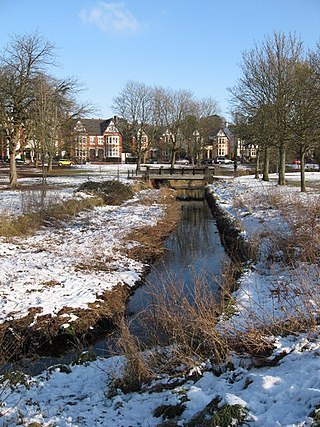
Roath is a district and community to the north-east of the city centre of Cardiff, capital of Wales. The area is mostly covered by the Plasnewydd electoral ward, and stretches from Adamsdown in the south to Roath Park in the north.
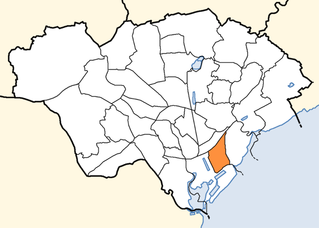
Splott is a district and community in the south of the city of Cardiff, capital of Wales, just east of the city centre. It was built up in the late 19th century on the land of two farms of the same name: Upper Splott and Lower Splott Farms. Splott is characterised by its once vast steelworks and rows of tightly knit terraced houses. The suburb of Splott falls into the Splott electoral ward.

Cathays is a district and community in the centre of Cardiff, capital of Wales. It is an old suburb of Cardiff established in 1875. It is densely populated and contains many Victorian terraced houses. The area falls into the Cathays ward. It is the third most populous community in Cardiff, having a population of 18,002 in 2011.

Butetown is a district and community in the south of the city of Cardiff, the capital of Wales. It was originally a model housing estate built in the early 19th century by the 2nd Marquess of Bute, for whose title the area was named. Commonly known as "Tiger Bay", this area became one of the UK's first multicultural communities with people from over 50 countries settled here by the outbreak of the First World War, working in the docks and allied industries. Some of the largest communities included the Somalis, Yemenis and Greeks, whose influence still lives on today. A Greek Orthodox church still stands at the top of Bute Street. It is known as one of the "five towns of Cardiff", the others being Crockherbtown, Grangetown, Newtown and Temperance Town. The population of the ward and community taken at the 2011 census was 10,125. It is estimated that the Butetown's population increased to 14,094 by 2019.
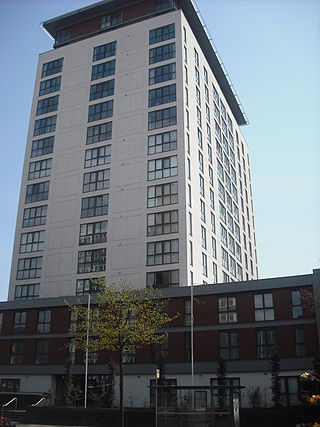
Adamsdown is an inner city area and community in the south of Cardiff, the capital city of Wales. Adamsdown is generally located between Newport Road, to the north and the mainline railway to the south. The area includes Cardiff Prison, Cardiff Magistrates' Court, Cardiff Royal Infirmary, a University of South Wales campus, and many streets of residential housing. There are two primary schools in the area Adamsdown Primary School and Tredegarville Primary School.
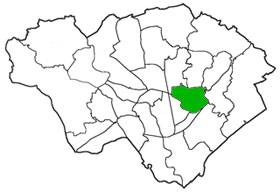
Penylan is a district and community in the east of Cardiff, the capital city of Wales, known for its Edwardian era period houses and spacious tree lined roads and avenues.
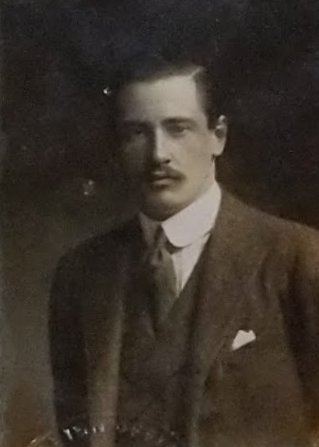
Lord Colum Edmund Crichton-Stuart was born on 3 April 1886 and died 18 August 1957, aged 71. Lord Colum Edmund Crichton-Stuart, who was baptised as Columba, was the fourth child of John Patrick Crichton-Stuart, 3rd Marquess of the County of Bute and the Hon. Gwendolen Mary Anne Fitzalan-Howard. He married Elizabeth Caroline Petty-Fitzmaurice, Marchioness of Lansdowne and the only daughter of Sir Edward Stanley Hope KCB and Constance C. Leslie. Lord Colum was educated at Harrow and Christ Church, Oxford University, England.

John Prichard was a Welsh architect in the neo-Gothic style. As diocesan architect of Llandaff, he was involved in the building or restoration of many churches in south Wales.
The Cardiff Deanery is a Roman Catholic deanery in the Archdiocese of Cardiff that oversees several churches in the city of Cardiff. It replaced the previous Cardiff East Deanery and Cardiff West Deanery, combining the two into one. The dean is centred at the Parish of St Mary's Canton.

Alexander Roos was an Italian-born British architect and urban planner. He was the architect to the Bute Estates in South Wales, for which he designed many buildings and laid out several areas of Cardiff.

St Peter's Church, Roath is the oldest surviving Roman Catholic church in Cardiff, the capital of Wales. It is administered by the Rosminians.

Cardiff County Borough Council, known as Cardiff City Council after Cardiff achieved city status in 1905, was the elected local authority that administered the town and county borough of Cardiff, Glamorgan, Wales between 1889 and 1974. The county borough council was replaced in 1974 by a district council, covering part of South Glamorgan and also known as Cardiff City Council.

Sophia Crichton-Stuart, Marchioness of Bute, formerly Lady Sophia Frederica Christina Rawdon-Hastings, was a Scottish noblewoman. She was the second wife of John Crichton-Stuart, 2nd Marquess of Bute, and the mother of the 3rd Marquess. Cardiff's Sophia Gardens are named after her.

St Joseph's Church, is a Roman Catholic church in Cardiff, Wales. It is administered by the Rosminians. It serves the areas of Gabalfa, Cathays, and Maindy.





















